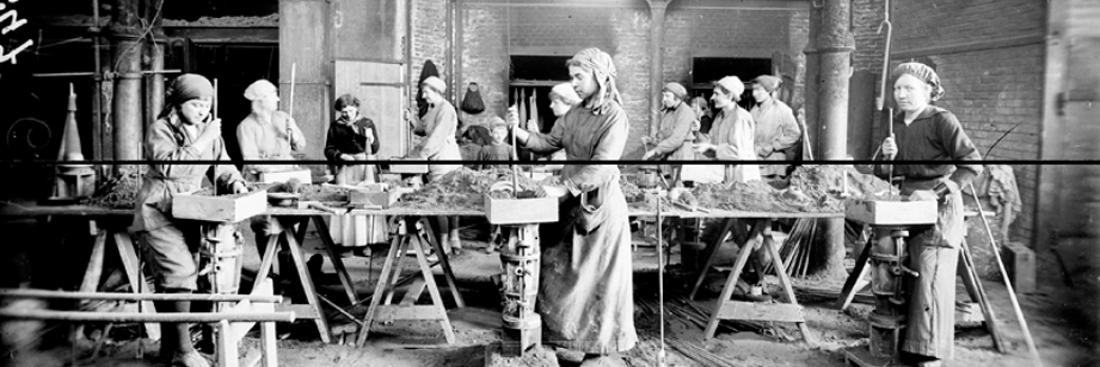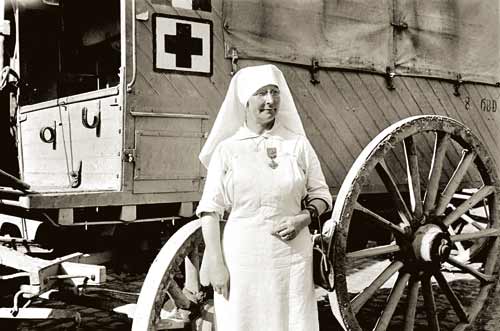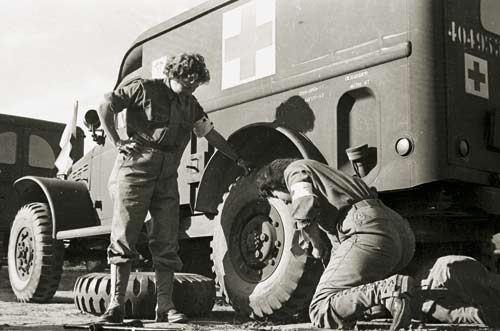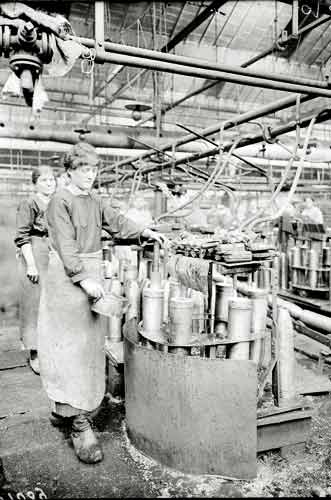L'émancipation des femmes dans la Grande Guerre

Corps 1
Did the Great War advance the emancipation of women ?
Corps 2
The collective memory, which conjures up images of Tomboys and women workers, tends to retain the notion that the Great War was an emancipating event for women. But much has been written on the question of the impact of wars on the relationships between the sexes and the position of women in society and the debate is not over yet. By showing that war is not just a masculine venture, that it mobilises women in tasks requiring skills and taking on responsibility, that it involves them in political battles and that it is often followed in western democracies by access to political rights, the first works on the history of women (in 1960 and 1970), supported by interviews with those women involved at the time, often concluded that it was an important factor in the emancipation of women. After critical reassessment of the sources and using a more relational approach, historians have since demonstrated that the trend, albeit temporary or superficial, was related to changes brought about by the conflicts. By its very nature and through the trauma it causes, war seems to be more conservative, even regressive, where relationships between the sexes are concerned. In their turn, the most recent studies give their own interpretations.
They once again make comparisons between the 1920's, with the blurring of sexual identity and the rise of positive images of Tomboys and lesbians and the tensions of the 1930's; they underestimate the impact of the wars on the continuing emancipation movement, founded on improvements in the quality of life and the general increase in individualism; indeed, they even defend the theory of a fundamental change in relationships between men and women (blurring of sexual identities, reconciliation of roles and relaxation of the pecking order). On each side, however, subtle differences bridge the gap between these points of view, which today highlight the difficulty of drawing firm conclusions, the importance of the scale of the study (individuals, groups or communities) and the time-scale involved (short, medium or long term), the impact of the angle of approach (social, cultural, legal etc.) and even the importance of the differences between women: differences of class, age, national identity or where they live. Women: a replacement work force? What happened for French women on the signing of the armistice and in the months, years even, that followed the end of hostilities? The first volume of the "La Femme en chemin, La Garçonne" trilogy, published in 1922, was a novel by Victor Margueritte which caused a scandal and resulted in its author being stripped of the Légion d'honneur. But the meaning of this "virtuous fable" (the term used by the author), where the financially and sexually independent short-haired heroine finally finds salvation in a relationship, is ambiguous. So lets look instead at the social and political reality of the time. The question of work must be understood in the long term. Because of the lack of manpower, Malthusian pre 1914 France was a land of immigration and a country with a high number of feminine workers: women constituted just over a third (7.2 million) of the working population. Like the young people and colonial workers, from 1915 onwards they were called upon, although often reluctantly, to replace the men who had been mobilised (more than 8 million) and work in the armaments factories (where they were known as "munitionnettes"). The "mobilisation " of women, however, remained limited, with the number of female staff working in industry and business at the end of 1917 having increased by just 20% on pre-war numbers. As the conflict appeared to be drawing to a close, praise gave way to calling these women opportunists, and asking them to give their jobs back to soldiers and go back home or to traditionally female jobs (most often in dressmaking and domestic service).
More brutal than military demobilisation, the demobilisation of women marked a desire to return to normal, in other words to the former situation, although that was impossible with 1.4 million servicemen dead, in other words more than 10% of the active male population of 1914, not to mention the wounded and disabled. In this context, the post-war changes were marked less by a global increase in female workers than by the emergence of new opportunities and changes in the sexual division of labour. Figures from census returns, which must be treated cautiously (especially with regard to the under-representation of unpaid female work), indicate a decline in female workers between the twenties and the sixties (in 1962 there was a working population of just 6.5 million), the war having reversed the 19th century trend towards an increase in the female workforce. But this decline, which was due to a reduction in the agricultural workforce during the 1920's (a rural exodus of widows and young girls committed to remaining single) and to the shrinkage of the active population pyramid, hid the changes. On the one hand, the critical lack of servants intensified, as such jobs were considered menial. On the other hand, the slump in jobs in dressmaking and home-working (except in Paris) was compensated by an increase in the number of women in the modern large-scale tailoring industry, where they were employed in repetitive, unskilled jobs. Lastly, jobs in the service industry were about to become the privileged place for women workers: in shops, banks, offices and post offices, where good manners were appreciated, in social and health care, which were becoming recognised professions (with the creation of qualifications for nurses, factory managers and, later, for social workers); in teaching and even in freelance work. The introduction of a baccalaureat for women in 1919, followed by the standardisation of male and female secondary education in 1924, allowed young girls to enter higher education and opened the door for women to qualified professions. Coupled with the fear of being single and the reversal of fortune of the middle classes, this feminisation of the service industry allowed young upper middle class girls to exercise a profession and have a limited right to work. In this respect, they were the main winners in the war, determined not to take after their mothers. Their role models were active, independent women, tennis player Suzanne Lenglen, scientist Marie Curie, the writer Colette and militants on social issues. However, professional equality in terms of choice, responsibility and pay was not on the agenda and there were many constraints, especially on their behaviour, that weighed heavily on these working women.
What happened in terms of civil and political rights? Powerful and diversified, the feminist movement of the Belle Époque was a feminisation of rights, demanding, after education for girls and a woman's right to work, amendments to the Civil Code (a married woman was considered a legal minor) and the right to vote. At the height of a suffragist campaign that had been active for several years, 1914 could have been the year of the woman, as French women were hoping to vote in the 1916 municipal elections. But the war shattered the momentum and redefined priorities: the feminist movement suspended its demands and committed itself to the patriotic fervour of the sacred Union, before suggesting, in vain, that female patriotism deserved some reward. The Civil Code was not amended until 1938 and even then, the application of the law granting full legal power to women was limited by matrimonial agreements. A sign of an obsession with demographics, the legislative measures taken at the beginning of the 1920's (the acts of the 31st July 1920 and the 27th March 1923, suppressing all information on contraception and "illegalising" abortion) were not about women's suffrage but rather about controlling their wombs, forcing them to become mothers. Despite the example shown by European neighbours (United Kingdom, Germany, Austria, Holland etc.) and some other States worldwide (138 million women voted in 1920 in 24 States) and despite militant activism (petitions, blank votes and international conferences) the famous suffragist poster, showing Europe in three colours, had to depict France in black (no feminine vote), like the distant and archaic Balkan peninsula. After a contradictory debate in May 1919 on granting women the right to vote in municipal elections, and taking into account the impact of the municipal vote on the senatorial elections, MPs voted in favour, by a very large majority (334 votes to 97) of Andrieux-Bon-Dumont's counter proposal to grant women full voting rights, but the senators refused to include the matter on the agenda, before voting against it in October 1922 (1).
A combination of the Right wing party's reluctance to acknowledge women in the political arena and the radical party's fear of a women's conservative vote, this scenario, repeated several times between the wars, led to the belated establishment of full suffrage in France (1944). However, the male monopoly of politics was somewhat weakened after the 1914-1918 war: public life became more accessible for women, as borne out by the appointment of female town counsellors (in a consultative role), the acknowledgement of the expertise of female organisations in matters of social and health policies and even further, by the inclusion of three female under-secretaries of State in the Popular Front government. Emancipation? As fashion clothing became more generally available, the most obvious overall benefit would appear to be an ease in movement and behaviour, acquired as a result of being on their own and taking on responsibilities. Rid of the restrictions of corsets and long tight-fitting clothes, bulky hats and sometimes even their chignons (with their tomboy haircuts), the female body was able to move. But the independent behaviour of some women, which drew on their experience from the war or was influenced by the modern ways of the Roaring Twenties, was out of line with the general mood and was stifled by the political and cultural manifestations of the trauma suffered by the French people. Without being able to take the study any further (2), lets just consider briefly the weight of grief borne by ex-servicemen, as well as the power of social and political thinking on the necessary differences between the sexes. In this respect, major changes came much later...
Notes : (1) We can also report some other unsuccessful proposals: family suffrage (number of votes proportional to the size of the family), suffrage for the dead (the right to vote for widows and the mothers of soldiers killed). (2) A long annotated version of this article appeared in 1914-1918: combats de femmes (Ed. Evelyne Morin-Rotureau), Autrement, 2004 (under the title: "La guerre, et après?")

Juliette Perdou, infirmière décorée de guerre, 15 juillet 1917. Source : ECPAD

Volontaires féminines conductrices de la 531e compagnie de transport, octobre 1943. Source : ECPAD

Atelier de soudure à l'usine Gillet frères, Lyon, juin 1917.
Source : ECPAD

